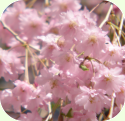Cherry Tree
Cherry trees are ornamental trees, that not only
bear fruit but are used in landcaping.
Other Names: Sakura, Japanese Flowering
Cherry,
Scientific Classification:
Kingdom: Plantae
Order: Rosales
Family: Rosaceae
Genus: Prunus
|
|

Cherry Tree - Cherry Blossoms |
|
Descriptions: Cherry trees are ornamental
trees with fragrant delicate pink or white blossoms.
Size: The height of a cherry tree varies
by species.
Symbolism: Cherry trees symbolize education
and feminine beauty. In Japan, cherry blossoms
symbolize the transience of life because of their
short blooming times. Falling blossoms are metaphors
for fallen warriors who died bravely in battle.
Cherry trees also symbolize goodluck and good
fortune. In Roman culture cherry blossoms symbolized
innocence.
Grow Details:
Grow Details
Soil Type: Well
Drained
Soil PH: PH 6.2 to 6.8
Water: Moist
Light: Full Sun
Grow Zone: 5, 6, 7, 8,
|
|
Characteristics
Height: Varies by species typically
6 to 50 feet tall.
Flower Colors: White, Pale Pink,
Pink, Dark Pink,
Propagation: Seeds or Grafting
Division/Transplants: n/a
Blooming Period: Spring
|
Type: Perennial Tree
Herbal Remedy Properties: The stems and
leaves of cherry trees are used as diuretics.
The cherry fruit is high and vitamin C and anti-oxidants,
it also has cleansing properties. Cherries are
helpful in managing arthritis, gout, liquid retention,
kidney stones, or gall stones.
Native Area: Cherry Trees are native to
the temperate regions of the Northern Hemisphere.
Two species of cherry trees are native to America,
three species in Europe, and the remainder are
native to Asia.
Other: Japan gave 3,020 cherry blossom
trees as a gift to the United States in 1912 to
celebrate the nations' then-growing friendship,
replacing an earlier gift of 2000 trees which
had to be destroyed due to disease in 1910.
|
